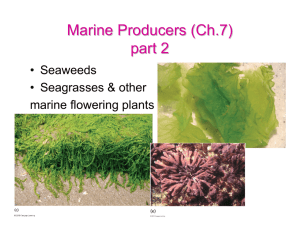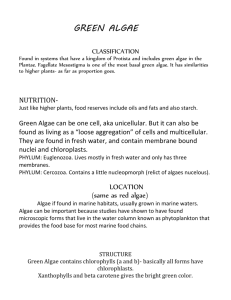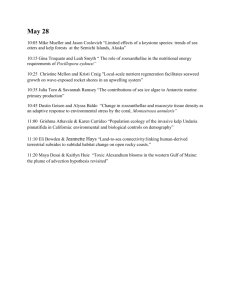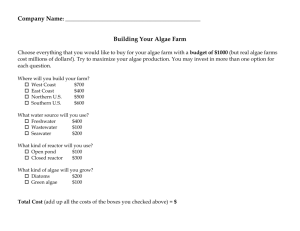Unit 1
advertisement
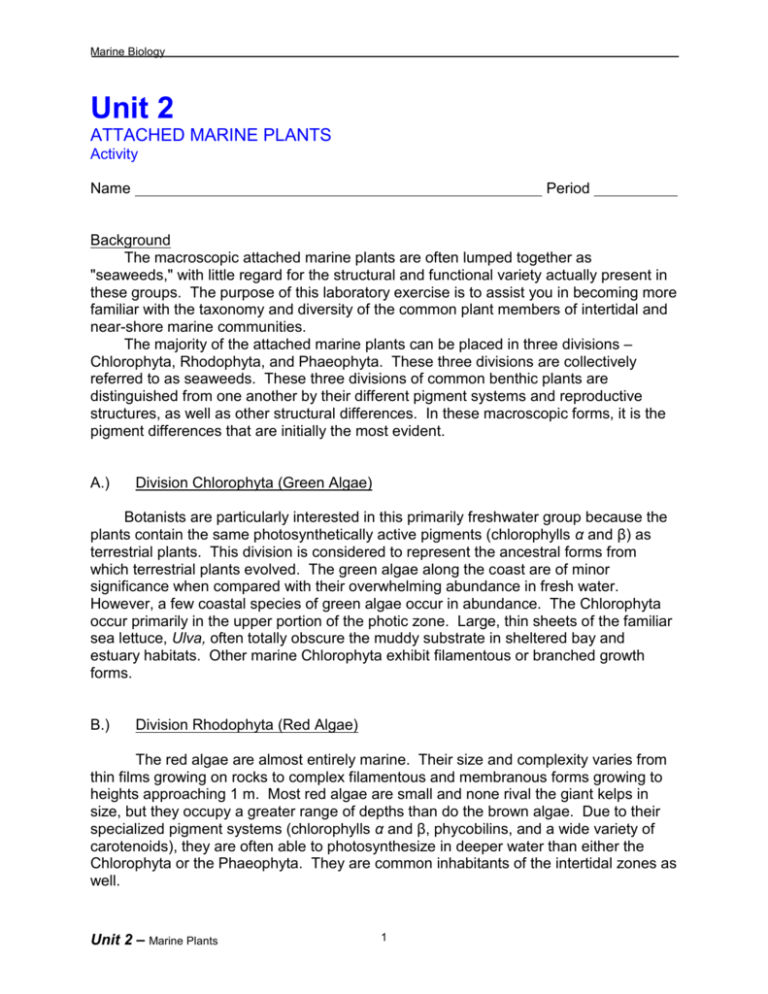
Marine Biology Unit 2 ATTACHED MARINE PLANTS Activity Name Period Background The macroscopic attached marine plants are often lumped together as "seaweeds," with little regard for the structural and functional variety actually present in these groups. The purpose of this laboratory exercise is to assist you in becoming more familiar with the taxonomy and diversity of the common plant members of intertidal and near-shore marine communities. The majority of the attached marine plants can be placed in three divisions – Chlorophyta, Rhodophyta, and Phaeophyta. These three divisions are collectively referred to as seaweeds. These three divisions of common benthic plants are distinguished from one another by their different pigment systems and reproductive structures, as well as other structural differences. In these macroscopic forms, it is the pigment differences that are initially the most evident. A.) Division Chlorophyta (Green Algae) Botanists are particularly interested in this primarily freshwater group because the plants contain the same photosynthetically active pigments (chlorophylls α and β) as terrestrial plants. This division is considered to represent the ancestral forms from which terrestrial plants evolved. The green algae along the coast are of minor significance when compared with their overwhelming abundance in fresh water. However, a few coastal species of green algae occur in abundance. The Chlorophyta occur primarily in the upper portion of the photic zone. Large, thin sheets of the familiar sea lettuce, Ulva, often totally obscure the muddy substrate in sheltered bay and estuary habitats. Other marine Chlorophyta exhibit filamentous or branched growth forms. B.) Division Rhodophyta (Red Algae) The red algae are almost entirely marine. Their size and complexity varies from thin films growing on rocks to complex filamentous and membranous forms growing to heights approaching 1 m. Most red algae are small and none rival the giant kelps in size, but they occupy a greater range of depths than do the brown algae. Due to their specialized pigment systems (chlorophylls α and β, phycobilins, and a wide variety of carotenoids), they are often able to photosynthesize in deeper water than either the Chlorophyta or the Phaeophyta. They are common inhabitants of the intertidal zones as well. Unit 2 – Marine Plants 1 Marine Biology Some forms of red algae secrete a stony CaC03 (calcium carbonate) skeleton. These calcareous red algae become more prevalent in warmer tropical and subtropical waters, especially on coral reefs. Plants of the genus Gelidium are processed commercially to yield a colorless gelatin, called agar, which solidifies as a gel at room temperatures. It is used as a growth medium for the culturing of bacteria. Several species of red algae (Chondrus, Porphyra, and Rhodymenia) are used directly as food or food additives. C. Division Phaeophyta (Brown Algae) The brown algae are almost entirely marine and are quite diverse in form and structure. The characteristic brownish or olive drab coloration of this group results from several carotenoids that mask the green chlorophyll pigments. Some types of brown algae are massive and form extensive kelp beds. The giant kelp plant Macrocystis pyrifera often grows to lengths of over 30 m and will live for several years. Fucus, Alara, Desmerestla, Laminaria, and several other genera have representatives on both the Atlantic and Pacific coasts. They often form extensive mats of algae on wave-swept rocky shores, and some occupy quiet estuarine shores as well. One member of the genus Sargassum (fig. 2.1a) occurs as large floating mats in the central North Atlantic Ocean (the Sargasso Sea). Large members of the Phaeophyta attach to the substrate by means of root-like holdfasts. Their leaf-like blades are supported by stem-like stipes. Although these algae appear to have the same morphological features as the roots, stems, and leaves of terrestrial plants, their cells are not organized with the same degree of complexity. For this reason botanists assign the terms blade, stipe, and holdfast to these analogous structures (fig. 2.1b). Fig. 2.1a Fig. 2.1b Pneumatocyst Stipe Blade Holdfast Unit 2 – Marine Plants 2 Marine Biology Division: Drawing: Genus: Species: Identifying characteristics: Division: Drawing: Genus: Species: Identifying characteristics: Division: Drawing: Genus: Species: Identifying characteristics: Unit 2 – Marine Plants 3
